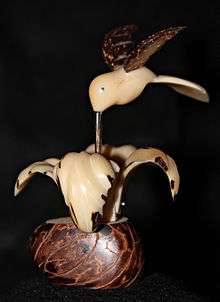Vegetable ivory
Vegetable ivory or tagua nut is a product made from the very hard white endosperm of the seeds of certain palm trees. Vegetable ivory is named for its resemblance to animal ivory. Species in the genus Phytelephas (literally "elephant plant"), native to South America, are the most important sources of vegetable ivory. The seeds of the Caroline ivory-nut palm from the Caroline Islands, natangura palm from Solomon Islands and Vanuatu,[1] and the real fan palm, from Sub-Saharan Africa, are also used to produce vegetable ivory.[2]


The material is called corozo or corosso when used in buttons.
Uses
An early use of vegetable ivory, attested from the 1880s, was the manufacture of buttons. Rochester, New York was a center of manufacturing where the buttons were "subjected to a treatment which is secret among the Rochester manufacturers", presumably improving their "beauty and wearing qualities".[3] Before plastic became common in button production, about 20% of all buttons produced in the US were made of vegetable ivory.[4]
Vegetable ivory has been used extensively to make dice, knife handles, and chess pieces. It is a very hard and dense material. Similar to stone, it is too hard to carve with a knife but instead requires hacksaws and files.[1]
Vegetable ivory is naturally white with a fine marbled grain structure. It can be dyed; dyeing often brings out the grain. It is still commonly used in buttons, jewelry, and artistic carving. Many vegetable ivory buttons were decorated in a way that used the natural tagua nut colour as a contrast to the dyed surface, because the dye did not penetrate deeper than the very first layer.[1][5] This also helps identify the material.
References
- Sentance, Bryan; Sentance, Polly (2009). "2 Central and South America". Craft Traditions of the World: Locally Made, Globally Inspiring. London, UK: Thames & Hudson. pp. 72–73. ISBN 9780500514665. OCLC 317919883.
- "Vegetable Ivory". Wayne's Word. Retrieved May 8, 2013.
- Ives, John M., ed. (1906). Rochester, 1906. Rochester Chamber of Commerce. p. 43.
- Smith, Phil; Kozlow, Karen. "One World Projects - Tagua Nut Main Page. Fair Trade". www.oneworldprojects.com. Retrieved 2016-08-29.
- Osbourne, Peggy Ann (1993). Button Button. Schiffler Publishing, Ltd. p. 158. ISBN 978-0-88740-464-1.